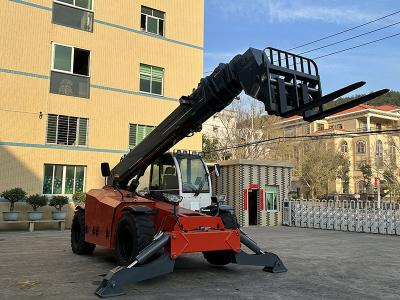As forklift drivers, we must pay attention to checking the forklift and make preparations before forklift operation. The following are precautions before forklift operation, which you can refer to
(I) Vehicle inspection
(1) Before big forklift truck operation, check the appearance, add fuel, lubricating oil and cooling water.
(2) Check the starting, running and braking performance.
(3) Check whether the lighting and sound signals are complete and effective.
(4) During the operation of the forklift, check whether the pressure and temperature are normal.
(5) After the forklift is running, check for external leakage and replace the seals in time.
(6) In addition to checking the above content, the battery forklift should also check the circuit of the battery forklift according to the relevant inspection content of the battery forklift.
(II) Starting
(1) Before starting, observe the surroundings and confirm that there are no obstacles that hinder driving safety. Then honk the horn first and then start.
(2) For vehicles with pneumatic brakes, the brake pressure gauge reading must reach the specified value before starting.
(3) When the forklift starts to load, the driver should first confirm that the cargo is stable and reliable.
(4) Start slowly and steadily.
(III) Driving
(1) When driving, the bottom of the fork should be kept 300-400mm above the ground and the mast should be tilted backward.
(2) Do not raise the fork too high when driving. When entering and exiting the work site or driving, pay attention to whether there are obstacles in the air. When driving with loads, if the fork is raised too high, it will increase the overall center of gravity height of the heavy duty forklift and affect the stability of the forklift.
(3) After unloading, the fork should be lowered to the normal driving position before driving.
(4) When turning, if there are pedestrians or vehicles nearby, a signal should be given and high-speed sharp turns are prohibited. High-speed sharp turns will cause the vehicle to lose lateral stability and overturn.
(5) It is strictly forbidden to shut down the engine and slide when the forklift is going downhill.
(6) Unless in special circumstances, it is forbidden to brake suddenly while driving with loads.
(7) When driving uphill or downhill at a speed higher than the first gear, the brakes shall not be used unless in special circumstances.
(8) When operating, the forklift must comply with the factory traffic rules and must maintain a certain safe distance from the vehicle in front.
(9) When the forklift is in operation, the load must be at the lowest position that does not hinder driving, and the mast must be tilted back appropriately. The load must not be raised except when stacking or loading. When transporting large objects, the objects block the driver's view. At this time, the forklift should be reversed.
(10) The forklift is controlled by the rear wheels, so you must always pay attention to the swing of the rear of the vehicle to avoid the phenomenon of turning too sharply that often occurs when beginners drive.
(11) It is prohibited to turn on a slope, and you should not drive across a slope.
(12) When the forklift is carrying goods downhill, it should drive in reverse to prevent the goods from falling.
(IV) Loading and unloading
(1) When loading items, the distance between the two forks should be adjusted as needed to balance the load on the two forks. The two forks should not be tilted. One side of the item should be close to the shelf. The weight of the forklift should comply with the regulations of the load center curve sign.
(2) The height of the load should not block the driver's view.
(3) During the loading and unloading process, the forklift must be braked.
(4) When the forklift approaches or leaves the object, the vehicle speed should be slow and steady, and the wheels should be careful not to crush the objects, wooden mats, etc., so as to avoid the crushed objects flying up and injuring people.
(5) When picking up goods with a fork, the fork should be inserted as deep as possible under the load, and the fork tip should not touch other goods or objects. The minimum mast tilt should be used to stabilize the load to prevent the load from sliding backwards. When lowering the load, the mast can be tilted forward slightly to facilitate the placement of the load and the withdrawal of the fork.
(6) It is prohibited to pick up goods at high speed and to use the fork to collide with hard objects.
(7) When the forklift is operating, it is prohibited for people to stand on the forks.
(8) When the forklift is operating, it is prohibited for people to stand around the forks to avoid the collapse of the goods and injuring people.
(9) It is prohibited to use the fork to lift people to work at heights to avoid accidents of falling from heights.
(10) It is not allowed to use the brake inertia to release objects




















